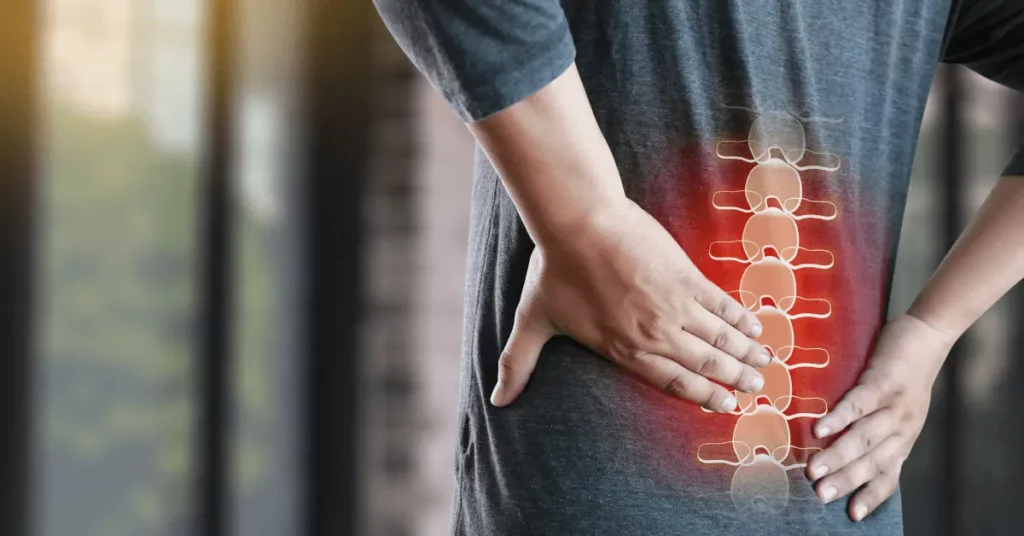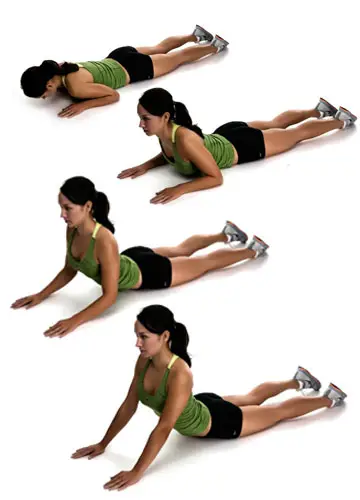Lower back discomfort– it’s a condition almost everyone has encountered at some point, bringing with it discomfort, disruption, and a desperate search for relief. As prevalent as it is, lower back pain remains misunderstood by many. It’s not just a condition that afflicts the elderly or those involved in heavy physical labor. It can affect anyone, anytime, anywhere – from the young and active to those living a more sedentary lifestyle. And with an array of potential causes, from muscle strain to nerve compression, it can seem daunting to understand exactly what’s happening in our bodies when lower back pain strikes.
In this comprehensive guide, we will shed light on the causes and symptoms of lower back pain, navigate through the maze of treatment options, and equip you with the knowledge to prevent its onset. Let’s get started!
Contents
What is Lower Back Discomfort?
 Lower back ache refers to discomfort in the lumbar region – the five vertebrae in the spine responsible for supporting the weight of the upper body. This area is inherently strong and flexible, allowing for movements such as bending and twisting. However, this high degree of mobility and the weight-bearing function it performs also makes it susceptible to injury and strain.
Lower back ache refers to discomfort in the lumbar region – the five vertebrae in the spine responsible for supporting the weight of the upper body. This area is inherently strong and flexible, allowing for movements such as bending and twisting. However, this high degree of mobility and the weight-bearing function it performs also makes it susceptible to injury and strain.
This can range from a dull, constant ache to a sudden, sharp sensation that leaves the person incapacitated. It can be short-term (acute), lasting a few days to weeks, or persistent (chronic), lasting for more than three months. Regardless of its duration or intensity, lower back pain can significantly affect an individual’s quality of life. Hence, understanding its causes and knowing how to manage it effectively are essential for recovery and prevention.
Causes of Pain In Lower Back

Lower back distress arises from a variety of conditions affecting the interconnected components of this complex region, including muscles, ligaments, nerves, and vertebrae. Let’s delve into some of the most common causes:
- Muscle or Ligament Strain: Heavy lifting, sudden awkward movements, or chronic poor posture can strain the muscles and spinal ligaments, leading to discomfort.
- Herniated or Ruptured Discs: Discs function as cushions between the bones (vertebrae) in your spine. They can herniate or rupture with age or injury, pressing on a nerve and causing back pain.
- Degenerative Disc Disease: As we age, intervertebral discs can break down or degenerate, which may result in lower back pain.
- Sciatica: This occurs when a herniated disc or bone spur compresses part of the nerve, causing sharp, burning pain that extends from the lower back to the back of the leg.
- Spondylolisthesis: This condition happens when one vertebra slips forward onto the bone directly beneath it, which can lead to lower back pain.
- Arthritis: Osteoarthritis can affect the lower back, and in some cases, inflammation or arthritis in the spine can lead to a narrowing of the space around the spinal cord, a condition called spinal stenosis.
- Skeletal Irregularities: A condition like scoliosis, a curvature of the spine, can lead to back pain, but generally not until middle age.
- Kidney Problems: Kidney stones or kidney infections can also cause pain in the lower back.
It’s important to remember that lower back pain can be multifactorial, meaning it can arise from several different causes simultaneously. Therefore, getting a proper diagnosis is critical to successful treatment.
Symptoms To Look Out For
 While lower back discomfort is the predominant symptom, other signs, and symptoms often accompany it. These can help pinpoint the cause of your discomfort and guide treatment. Here are common symptoms you should look out for:
While lower back discomfort is the predominant symptom, other signs, and symptoms often accompany it. These can help pinpoint the cause of your discomfort and guide treatment. Here are common symptoms you should look out for:
- Pain Radiating Down Your Legs: Pain that extends to your buttocks, thighs, or even down to your foot could be a sign of sciatica, a condition where the sciatic nerve is compressed or irritated.
- Intensified Pain with Movement: If your pain worsens with certain movements or positions, such as bending, lifting, standing, or walking, it may indicate a musculoskeletal strain or disc-related issue.
- Stiffness or Limited Range of Motion: Difficulty moving, or reduced flexibility in your lower back, can be symptomatic of several lower back conditions, including muscle strain, arthritis, or disc problems.
- Muscle Spasms or Tightness: These often accompany lower back pain and might be a natural response to inflammation or irritation of the nerves.
- Numbness, Tingling, or Weakness: These sensations in your back, buttocks, or leg might be signs of nerve compression, such as that caused by a herniated disc or spinal stenosis.
- Severe, Constant Pain: Pain that doesn’t improve with rest, is severe, or is constant might indicate a more serious condition, such as a vertebral fracture or underlying disease.
- Accompanying Symptoms: Lower back pain associated with symptoms such as unexplained weight loss, fever, urinary incontinence, bowel incontinence, or severe abdominal pain can indicate serious underlying conditions and necessitate immediate medical attention.
Identifying these symptoms can be instrumental in diagnosing the source of your lower back pain. Always remember, if your symptoms are severe or persist despite home care, it is essential to consult a healthcare provider.
Diagnosis of Pain In Your Lower Back

Diagnosing the cause of lower back discomfort typically involves a multi-step process. The initial diagnosis is often based on your description of symptoms, medical history, and a physical examination. In some cases, imaging tests may be required for a definitive diagnosis. Let’s break down this process:
- Medical History: Your healthcare provider will begin by asking about your symptoms, including their onset, intensity, duration, what makes them better or worse, and whether you’ve had similar episodes in the past. They’ll also ask about your personal and family medical history and lifestyle habits such as exercise, work, and sleep patterns.
- Physical Examination: The doctor will then conduct a physical examination to assess your mobility, posture, physical condition, and neurological health. They’ll look for areas of tenderness, muscle weakness, and any limitations in your range of motion. This might involve you performing certain movements to see when and how pain is triggered.
- Diagnostic Tests: If the cause of your back pain is not apparent from your history and physical exam, or if a specific condition needs to be ruled out, your doctor may order one or more imaging tests. These could include:
- X-rays: These can reveal bony abnormalities, such as fractures, arthritis, or alignment issues in the spine.
- MRI or CT scans: These provide more detailed images of soft tissues and can help identify herniated discs, pinched nerves, or other sources of compression.
- Blood Tests: These can help detect infections or autoimmune diseases that might be causing or contributing to your back pain.
These diagnostic tools, combined with your symptoms and medical history, enable healthcare providers to diagnose your lower back pain accurately.
How Do I Fix Pain in My Lower Back At Home?
 It’s important to note that while severe or persistent pain in your lower back should always be evaluated by a healthcare provider, mild or acute pain often responds well to self-care methods. Here are some strategies you can apply at home to alleviate your discomfort:
It’s important to note that while severe or persistent pain in your lower back should always be evaluated by a healthcare provider, mild or acute pain often responds well to self-care methods. Here are some strategies you can apply at home to alleviate your discomfort:
- Heat and Cold Therapy: Applying heat or cold to the affected area can alleviate discomfort. A warm bath or a hot water bottle can help relax tense muscles and improve blood flow. On the other hand, a cold pack can reduce inflammation and numb the area, easing the pain.
- Over-The-Counter Pain Relievers: Non-prescription medications like ibuprofen or acetaminophen can provide temporary relief from lower back pain. Remember to use these medications as directed by the package instructions.
- Maintain Good Posture: Poor posture can strain your back muscles and spinal ligaments, contributing to pain. Be mindful of keeping your back straight while standing and sitting, and make sure your workstation is ergonomically set up.
- Practice Mindfulness and Relaxation: Stress can exacerbate back pain. Techniques like deep breathing, meditation, or yoga can help reduce stress and relax your mind and body, potentially easing your discomfort.
- Regular Exercise: Incorporate exercises that strengthen your core and improve flexibility into your routine. These can help prevent future occurrences of lower back pain.
- Sleep Well: Poor sleep can contribute to back distress. Make sure your mattress and pillows are supportive and comfortable, and try sleeping on your side with a pillow between your knees to maintain spinal alignment.
Remember, while these strategies can help with mild lower back aches, it’s important to seek professional advice if your pain is severe, doesn’t improve with self-care, or is accompanied by other concerning symptoms.
Professional Treatment Options Available
If self-care strategies don’t provide relief, or if your lower back distress is severe or persistent, it’s time to seek professional help. There’s a range of treatment options available, depending on the cause and severity of your pain:
- Physical Therapy and Exercise: A physiotherapist can guide you through a series of exercises designed to strengthen your core, improve flexibility, and promote optimal spinal health. They may also use techniques like heat, cold, electrical stimulation, or ultrasound to alleviate pain.
- Medication: Depending on your symptoms and the cause of your back pain, different types of medications might be recommended. These can include over-the-counter pain relievers, muscle relaxants, topical creams, and in some cases, prescription pain medication. Inflammatory conditions might be managed with corticosteroids.
- Injections: If the discomfort stems from nerve inflammation, your healthcare provider might recommend injections of corticosteroids or anesthetics directly into the area around the affected nerves to reduce inflammation and alleviate pain.
- Manual Therapy: Techniques like massage, mobilization, or spinal manipulation performed by trained health professionals, such as chiropractors or osteopaths, can help relieve lower back pain in some cases.
- Alternative Therapies: Some people find relief through acupuncture, transcutaneous electrical nerve stimulation (TENS), or biofeedback.
- Surgery: This is usually the last resort when other treatments haven’t worked, and the pain is severe and debilitating. The type of surgery depends on the cause of the backache and can range from disc replacement to spinal fusion.
Remember, the best treatment for you will depend on the cause and severity of your pain, your overall health, and how the pain affects your daily activities.
In Conclusion
Pain in the lower back can be a significant hurdle in your daily life, but understanding its causes, symptoms, and potential treatment options can empower you to manage it effectively. Remember, while home remedies can be a great starting point, seeking professional help is crucial if your discomfort is persistent, severe, or accompanied by other worrying symptoms.
At PhysioMantra, we dedicate ourselves to alleviating your pain and enhancing your overall well-being. Our skilled physiotherapists can guide you through personalized exercises and treatment strategies to improve your lower back health.
If you’re experiencing Back pain, physical therapy for back pain at PhysioMantra can help: Book an online physical therapy session.



